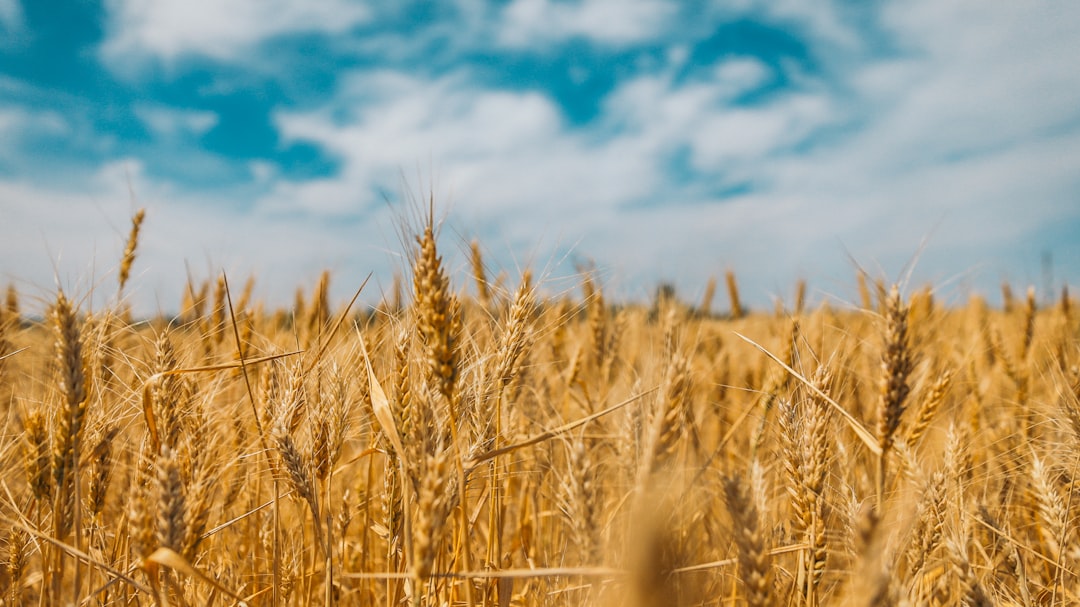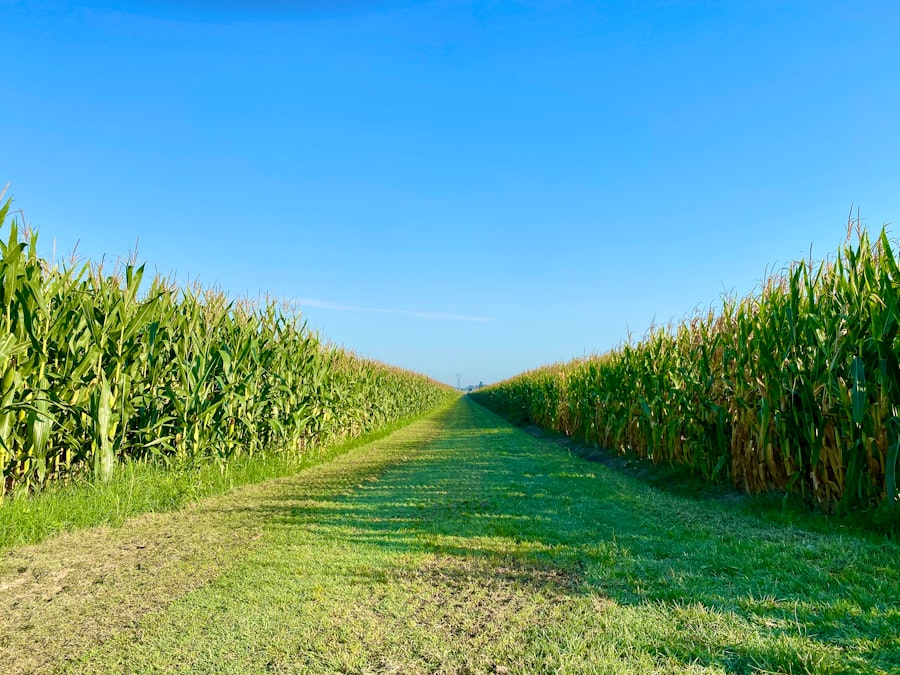Spacing Corn: How Far Apart to Plant?

Corn spacing refers to the distance between individual corn plants in a field. It is an important factor to consider when planting corn as it can greatly impact the yield of the crop. Proper corn spacing ensures that each plant has enough space to grow and access the necessary resources, such as sunlight, water, and nutrients, for optimal growth and development.
Key Takeaways
- Proper corn spacing is crucial for maximizing yield and ensuring healthy plant growth.
- Factors to consider when spacing corn include variety, soil type, and planting method.
- The ideal corn spacing can be determined based on the specific needs of the variety being planted.
- Recommended corn spacing varies depending on the variety, with some requiring wider spacing than others.
- Achieving uniform corn spacing is important for ensuring consistent growth and yield.
The Importance of Proper Corn Spacing
Improper corn spacing can have negative effects on the yield of the crop. If corn plants are spaced too closely together, they will compete for resources, resulting in stunted growth and reduced yields. On the other hand, if corn plants are spaced too far apart, there will be wasted space in the field, reducing the overall yield potential.
Proper corn spacing has several benefits. Firstly, it allows each plant to have access to adequate sunlight. Corn is a sun-loving crop and requires ample sunlight for photosynthesis, which is essential for growth and grain production. Proper spacing ensures that each plant receives enough sunlight without being shaded by neighboring plants.
Secondly, proper corn spacing allows for efficient water and nutrient uptake. Each corn plant requires a certain amount of water and nutrients to grow and produce grain. If plants are spaced too closely together, they will compete for these resources, leading to uneven growth and reduced yields. By providing enough space between plants, each plant can access the necessary water and nutrients without competition.
Factors to Consider When Spacing Corn
When determining the ideal corn spacing for a field, several factors need to be considered:
1. Soil type and fertility: Different soil types have different water-holding capacities and nutrient levels. Sandy soils drain quickly and may require closer spacing to ensure adequate water uptake, while clay soils retain moisture longer and may require wider spacing. Soil fertility levels also play a role in determining corn spacing, as nutrient availability can impact plant growth and yield.
2. Climate and weather conditions: The climate and weather conditions of a region can influence corn spacing. In areas with high rainfall, wider spacing may be necessary to prevent waterlogging and disease issues. In dry regions, closer spacing may be needed to maximize water use efficiency.
3. Corn variety and growth habit: Different corn varieties have different growth habits, such as tall or short stature, and different ear sizes. These factors can influence the ideal spacing for each variety. Tall varieties may require wider spacing to prevent shading, while short varieties may be able to tolerate closer spacing.
4. Equipment and planting method: The type of planting equipment and method used can also impact corn spacing. Some planters have adjustable row widths, allowing for flexibility in spacing. Additionally, the planting method, such as single-row or twin-row planting, can affect the ideal spacing.
How to Determine the Ideal Corn Spacing
| Factors | Ideal Corn Spacing | Impact on Yield |
|---|---|---|
| Soil Type | 30 inches | High |
| Plant Population | 30,000 plants per acre | High |
| Row Orientation | North-South | Medium |
| Planting Depth | 1.5-2 inches | Medium |
| Fertilizer Application | Before planting | Low |
There are several methods to determine the ideal corn spacing for a field:
1. Calculating plant population: Plant population refers to the number of plants per unit area. To calculate the ideal plant population, factors such as yield goal, seed size, germination rate, and expected stand loss need to be considered. By determining the desired plant population, farmers can then calculate the appropriate spacing between plants.
2. Using seed spacing charts: Seed spacing charts provide recommended spacing based on factors such as soil type, climate conditions, and corn variety. These charts can serve as a starting point for determining the ideal corn spacing for a specific situation.
3. Conducting on-farm trials: On-farm trials involve planting different corn spacings in small plots within a field to determine which spacing results in the highest yield. By comparing yields from different spacings, farmers can identify the optimal spacing for their specific conditions.
Recommended Corn Spacing for Different Varieties
The recommended corn spacing can vary depending on the type of corn being grown. Here are some general recommendations:
1. Sweet corn: For sweet corn, which is typically harvested for its tender kernels, closer spacing is often recommended. Spacing between plants can range from 8-12 inches, with rows spaced 30-36 inches apart.
2. Field corn: Field corn, which is grown for animal feed or industrial uses, generally requires wider spacing compared to sweet corn. Spacing between plants can range from 6-10 inches, with rows spaced 30-40 inches apart.
3. Popcorn: Popcorn varieties often have smaller ears and shorter plants compared to field corn. Closer spacing is typically recommended, with spacing between plants ranging from 6-8 inches and rows spaced 30-36 inches apart.
It is important to note that these are general recommendations and may need to be adjusted based on specific hybrid or variety characteristics.
Tips for Achieving Uniform Corn Spacing

To achieve uniform corn spacing, farmers should consider the following tips:
1. Proper calibration of planting equipment: It is essential to calibrate planting equipment to ensure accurate seed placement and spacing. This involves adjusting the planter settings to ensure that the desired seed population and spacing are achieved.
2. Maintaining consistent planting depth: Consistent planting depth is crucial for uniform emergence and growth. Uneven planting depths can result in uneven emergence and growth, leading to yield losses. Planters should be adjusted to ensure that seeds are planted at a consistent depth.
3. Monitoring seed placement and spacing: Regularly inspecting the field during planting can help identify any issues with seed placement or spacing. Adjustments can be made as needed to ensure uniformity.
The Role of Soil Fertility in Corn Spacing
Soil fertility plays a significant role in determining the ideal corn spacing. Nutrient availability in the soil can impact plant growth and yield potential. Soil testing should be conducted prior to planting to determine nutrient levels and make any necessary adjustments.
If soil fertility levels are low, closer spacing may be beneficial to ensure that each plant has access to an adequate supply of nutrients. On the other hand, if soil fertility levels are high, wider spacing may be appropriate to prevent excessive competition for nutrients.
Common Mistakes to Avoid When Spacing Corn
There are several common mistakes that farmers should avoid when spacing corn:
1. Overcrowding or undercrowding plants: Planting corn too closely together or too far apart can have negative effects on yield. Overcrowding can lead to competition for resources and reduced growth, while undercrowding can result in wasted space and reduced yield potential.
2. Inconsistent spacing within rows: Inconsistent spacing within rows can lead to uneven growth and reduced yields. It is important to ensure that each plant is spaced evenly within the row for optimal growth and development.
3. Ignoring soil fertility levels: Soil fertility levels should not be overlooked when determining corn spacing. Ignoring soil fertility levels can result in nutrient deficiencies or excesses, impacting plant growth and yield potential.
Adjusting Corn Spacing for Different Growing Conditions
Corn spacing may need to be adjusted based on different growing conditions:
1. Adjusting spacing for drought or wet conditions: In drought conditions, closer spacing may be beneficial to maximize water use efficiency. Closer spacing allows plants to compete less for limited water resources. In wet conditions, wider spacing may be necessary to prevent waterlogging and disease issues.
2. Spacing adjustments for different planting dates: Planting corn at different times of the year may require adjustments in spacing. For early planting, wider spacing may be needed to allow for slower growth in cooler temperatures. For late planting, closer spacing may be necessary to maximize yield potential in a shorter growing season.
Maximizing Yield with Proper Corn Spacing
Proper corn spacing is essential for maximizing yield potential. By providing each plant with enough space to grow and access necessary resources, such as sunlight, water, and nutrients, farmers can ensure optimal growth and development. Factors such as soil type, climate conditions, corn variety, and equipment should be considered when determining the ideal corn spacing. Regular monitoring and adjustments can help achieve uniform spacing and maximize yield potential.
If you’re curious about the optimal spacing for planting corn, you might find this article on Lawn World’s website quite informative. It delves into the question of how far apart corn should be planted to ensure healthy growth and maximum yield. To learn more, check out their article on corn planting spacing here.
FAQs
What is the recommended distance for planting corn?
The recommended distance for planting corn varies depending on the type of corn being planted and the farming method being used. Generally, corn should be planted in rows that are 30-36 inches apart, with the seeds spaced 8-12 inches apart within the row.
What is the purpose of spacing corn plants?
Spacing corn plants allows each plant to have enough room to grow and develop properly. It also helps to prevent competition for nutrients, water, and sunlight, which can lead to stunted growth and reduced yields.
What are some factors that can affect the spacing of corn plants?
Some factors that can affect the spacing of corn plants include the type of soil, the climate, the availability of water and nutrients, and the farming method being used. Farmers may also adjust the spacing of their corn plants based on their specific goals and objectives.
What are some common methods for planting corn?
Some common methods for planting corn include conventional tillage, no-till farming, and strip-till farming. Each method has its own advantages and disadvantages, and farmers may choose the method that best suits their needs and resources.
What are some benefits of planting corn in rows?
Planting corn in rows allows for easier weed control, better access to the plants for fertilization and pest management, and more efficient use of resources such as water and nutrients. It also helps to ensure that each plant has enough space to grow and develop properly.



